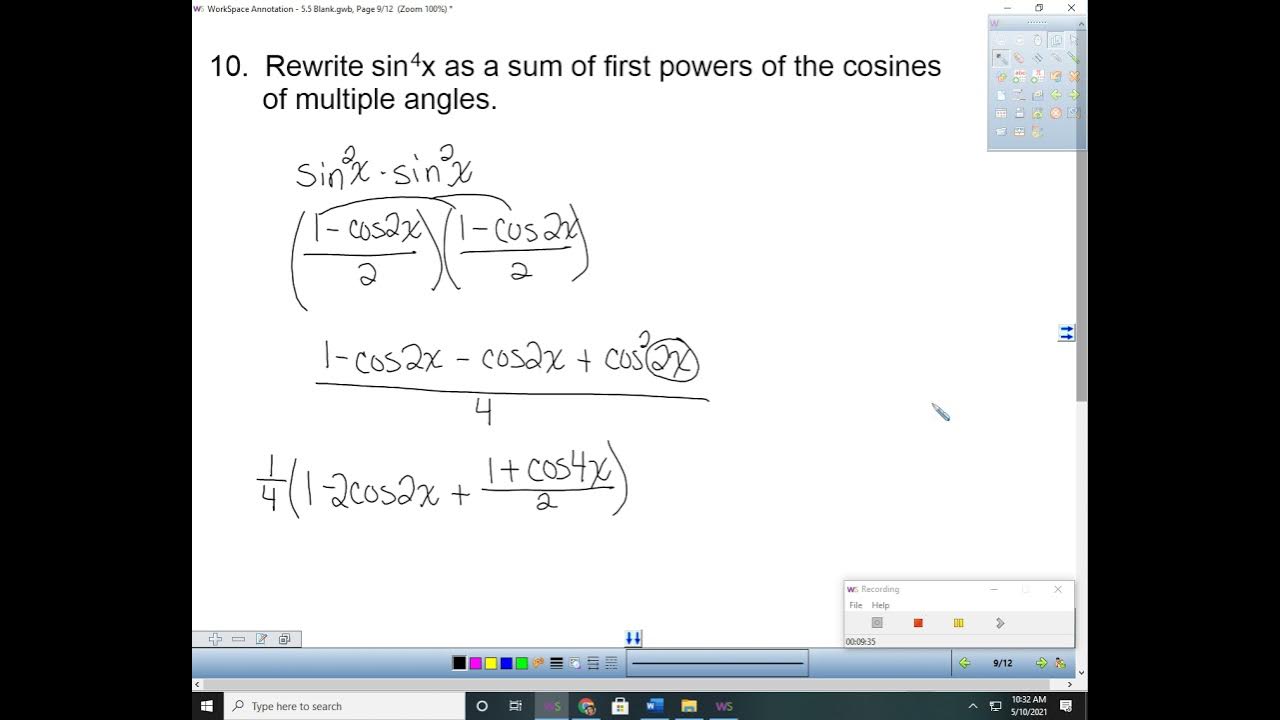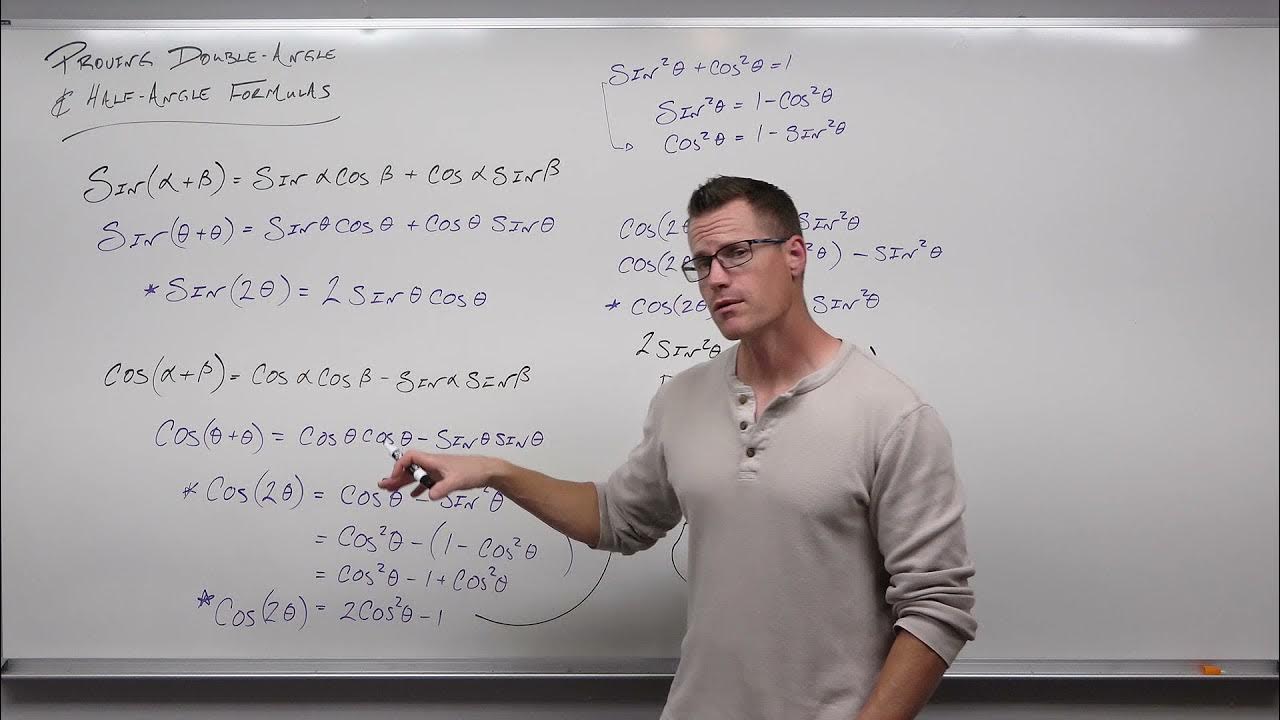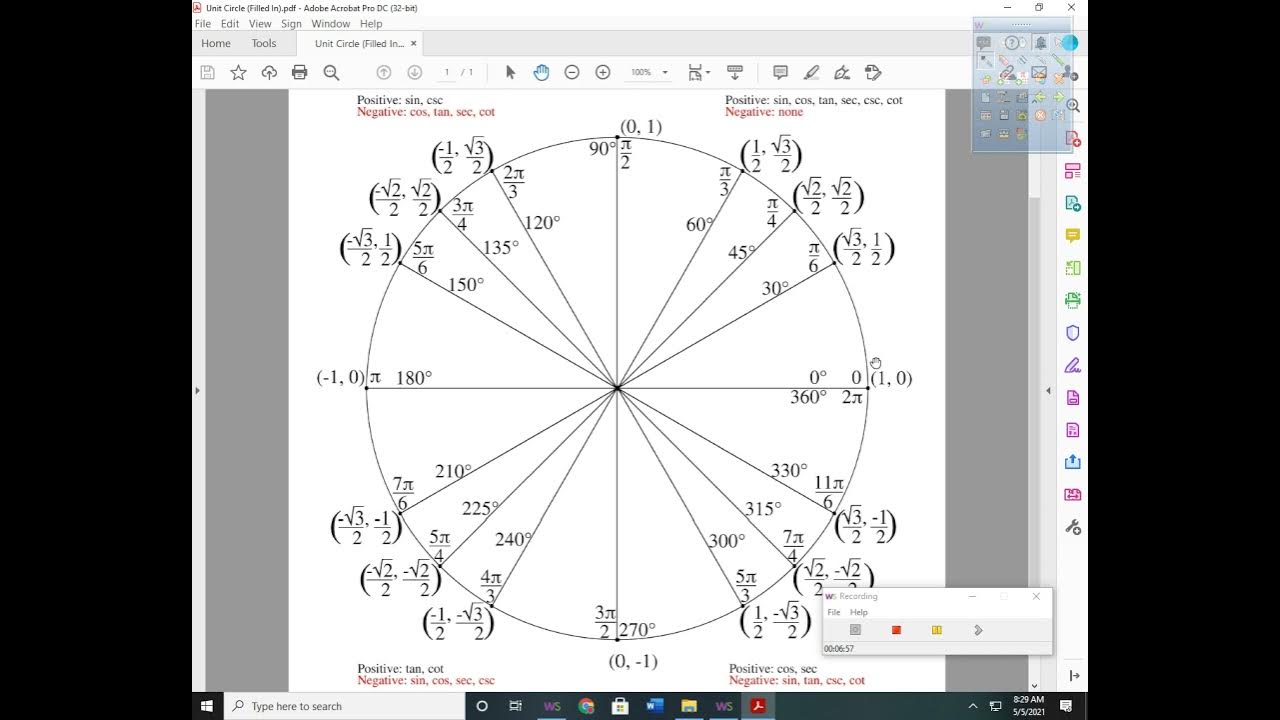Verifying Trigonometric Identities With Double Angle Formulas
TLDRThis script delves into verifying trigonometric identities using double angle formulas. It begins by demonstrating the equivalence of (sinθ + cosθ)^2 to sin(2θ) + 1, then moves on to show that sin(2θ) equals 2tanθ/(1 + tan^2θ). The video also covers the identity 1 - tan^2θ = cos(2x)/cos^2(x) and the reduction of angles using double angle formulas for cosine. It concludes with an example of verifying the identity for cosine of 3x, using sum and difference formulas for cosine instead of double angle formulas due to the odd angle. The script is an educational guide for students to understand and apply trigonometric identities.
Takeaways
- 🔍 The script focuses on verifying trigonometric identities using double angle formulas.
- 📚 It demonstrates the process of proving the identity \( \sin(\theta) + \cos(\theta)^2 = \sin(2\theta) + 1 \) step by step.
- 📈 The script shows how to expand and simplify expressions using trigonometric identities, such as \( \sin^2(\theta) + \cos^2(\theta) = 1 \).
- 📝 It explains the verification of the identity \( \sin(2\theta) = 2\tan(\theta) / (1 + \tan^2(\theta)) \) using quotient and Pythagorean identities.
- 📉 The process of transforming \( 1 - \tan^2(\theta) \) into \( \cos(2\theta) / \cos^2(\theta) \) is detailed, highlighting the use of common denominators.
- 📜 The script introduces special formulas for cosine, such as the double angle formula in three different forms.
- 🔢 It covers the reduction of higher angle powers, like \( \cos(4x) \), to lower ones using repeated application of double angle formulas.
- 📐 The script explains how to verify the identity \( \cos(3x) = 4\cos^3(x) - 3\cos(x) \) using sum and difference formulas for cosine.
- 📘 The importance of converting sine expressions to cosine when working with identities is emphasized.
- 📌 The script concludes by summarizing the method of using double angle formulas to reduce angles and verify identities.
Q & A
What is the first identity problem discussed in the script?
-The first identity problem discussed is to verify that sine plus cosine squared equals sine two theta plus one.
How does the script suggest to start verifying the identity sine plus cosine squared equals sine two theta plus one?
-The script suggests starting by writing the expression twice, multiplying sine theta by sine theta and cosine theta by cosine theta, and then simplifying using the Pythagorean identity sine squared plus cosine squared equals one.
What is the double angle formula for sine that is used in the script?
-The double angle formula for sine used in the script is sine 2 theta equals 2 sine theta cosine theta.
How is the double angle formula applied to verify the identity involving sine two theta?
-The double angle formula is applied by expressing sine two theta as 2 sine theta cosine theta and then simplifying the expression to show that it equals sine two theta plus one.
What is the second identity problem presented in the script?
-The second identity problem is to show that sine two theta equals two tangent theta divided by one plus tangent squared theta.
How does the script transform the left side of the identity involving sine two theta and tangent theta?
-The script transforms the left side by expressing sine two theta as 2 sine theta cosine theta, multiplying by 1 over cosine squared theta, and then simplifying to show that it equals two tangent theta over one plus tangent squared theta.
What trigonometric identity is used to simplify the expression involving tangent and secant squared?
-The script uses the Pythagorean identity that secant squared equals 1 plus tangent squared to simplify the expression.
What is the third identity problem discussed in the script?
-The third identity problem is to show that 1 minus tan squared equals cosine 2x divided by cosine squared x.
How does the script suggest to start verifying the identity involving 1 minus tan squared?
-The script suggests starting by expressing tan squared as sine squared divided by cosine squared and then multiplying by one over cosine squared to get a common denominator.
What double angle formula for cosine is used in the script to verify the identity involving cosine four x?
-The script uses the double angle formula for cosine which states that cosine 2 theta equals two cosine squared theta minus one, and applies it iteratively to reduce the angle from 4x to 1x.
How does the script simplify the expression for cosine four x using the double angle formula?
-The script simplifies the expression by first expressing cosine four x as two times cosine squared two x minus one, and then further reducing it to terms of x by applying the double angle formula again.
What is the final identity problem presented in the script?
-The final identity problem is to show that cosine of 3x equals 4 cosine cubed x minus 3 cosine x.
How does the script suggest to approach the verification of the identity involving cosine of 3x?
-The script suggests using the sum and difference formula for cosine, expressing 3x as 2x plus x, and then simplifying the expression to show that it equals 4 cosine cubed x minus 3 cosine x.
Outlines
📚 Verification of Trigonometric Identities with Double Angle Formulas
This paragraph focuses on verifying trigonometric identities using double angle formulas. It begins by demonstrating that \(\sin(\theta) + \cos(\theta)^2 = \sin(2\theta) + 1\), through a step-by-step algebraic manipulation. The process involves expanding the left side and using the Pythagorean identity \(\sin^2(\theta) + \cos^2(\theta) = 1\) to simplify the expression. The paragraph also shows how to verify another identity, \(\sin(2\theta) = \frac{2\tan(\theta)}{1 + \tan^2(\theta)}\), by converting \(\sin(2\theta)\) into \(2\sin(\theta)\cos(\theta)\) and then using trigonometric identities to match the right side of the equation. The explanation emphasizes the importance of keeping track of angles and using the double angle formula to break down larger angles into smaller ones.
🔍 Exploring Double Angle Formulas and Their Applications
The second paragraph delves deeper into the application of double angle formulas, specifically for cosine. It introduces the three forms of the double angle formula for cosine and explains how to use them to simplify expressions involving cosine of multiple angles. The paragraph provides a detailed example of reducing \(\cos(4x)\) to an expression in terms of \(x\) by applying the double angle formula twice. It also discusses the process of combining fractions and recognizing patterns that match the double angle formulas. The summary concludes with the verification of the identity \(\cos(4x) = 8\cos^4(x) - 8\cos^2(x) + 1\), showcasing the step-by-step algebraic manipulation and the use of the double angle formula to achieve the desired result.
📘 Demonstrating the Verification of Trigonometric Identities for Odd Multiples
This paragraph discusses the verification of trigonometric identities for odd multiples of angles, such as \(\cos(3x)\). It explains that double angle formulas cannot be directly applied to odd multiples, and instead, the sum and difference formulas for cosine should be used. The paragraph provides a step-by-step guide on how to express \(\cos(3x)\) as \(4\cos^3(x) - 3\cos(x)\) by first breaking down \(3x\) into \(2x + x\) and then applying the sum and difference formula for cosine. The explanation includes converting sine expressions into cosine expressions and simplifying the resulting expression to match the original identity. The paragraph concludes with the successful verification of the identity, demonstrating the correct application of trigonometric identities and formulas.
📌 Conclusion on Verifying Trigonometric Identities
The final paragraph succinctly wraps up the process of verifying trigonometric identities. It emphasizes the method of using double angle formulas to reduce larger angles to smaller ones, such as reducing \(4x\) to \(1x\) by applying the formula twice. The paragraph also highlights the importance of using the correct trigonometric identities based on whether the angle multiple is even or odd. It concludes with a brief mention of another identity verification example, reinforcing the concepts discussed throughout the script.
Mindmap
Keywords
💡Double Angle Formula
💡Sine
💡Cosine
💡Tangent
💡Pythagorean Identities
💡Sine Squared
💡Cosine Squared
💡Trigonometric Identities
💡Quotient Identity
💡Sum and Difference Formulas
Highlights
Verification of the identity problem with double angle formulas.
Demonstration that sine plus cosine squared equals sine two theta plus one.
Breaking down the expression sine theta plus cosine theta squared into components.
Using the Pythagorean identity to simplify sine squared plus cosine squared to one.
Verification of the identity by showing the left side equals the right side.
Introduction to the double angle formula for sine 2 theta.
Conversion of sine two theta to two sine theta cosine theta.
Manipulation of tangent and secant identities to verify another identity.
Explanation of the relationship between secant squared and tangent squared.
Verification of the identity 1 minus tan squared equals cosine 2x over cosine squared x.
Use of the double angle formula for cosine to simplify expressions.
Reduction of the angle from 4x to 1x using the double angle formula.
Introduction of special formulas for cosine and their different forms.
Application of the double angle formula to verify the identity for cosine four x.
Step-by-step foiling and simplification of the expression for cosine four x.
Combining like terms to reach the final verified identity for cosine four x.
Exploration of the sum and difference formula for cosine when dealing with odd angles.
Conversion of sine expressions to cosine using the Pythagorean identity.
Final verification of the identity for cosine of 3x.
Transcripts
Browse More Related Video

Inverse Trig Functions With Double Angle Formulas and Half Angle Identities - Trigonometry

5.5 Multiple Angle and Product to Sum Formulas (Part 2)

Proving the Double and Half Angle Formulas for Trigonometry (Precalculus - Trigonometry 27)

How To Solve Trigonometric Equations With Multiple Angles - Trigonometry

5.5 Multiple Angle and Product to Sum Formulas (Part 1)

Trig Identities
5.0 / 5 (0 votes)
Thanks for rating: